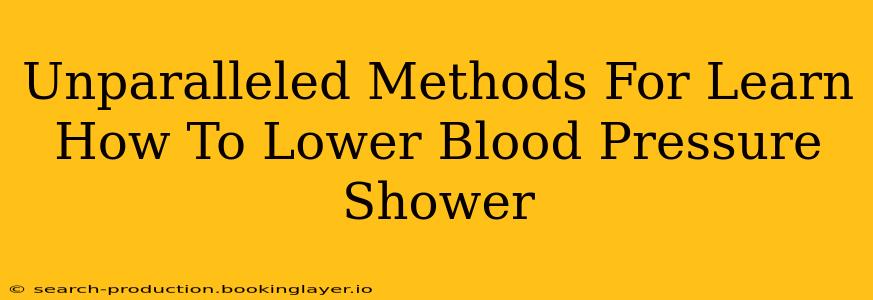High blood pressure, or hypertension, is a serious health concern affecting millions worldwide. While medication is often necessary, incorporating simple lifestyle changes can significantly impact your blood pressure levels. One surprising area where you can make a difference? Your daily shower! This article explores unparalleled methods for lowering blood pressure while enjoying your shower routine.
Understanding the Link Between Blood Pressure and Showering
Before delving into specific techniques, let's establish the connection. While a shower won't magically cure hypertension, certain practices can influence your blood pressure in positive ways. These methods primarily focus on relaxation, temperature regulation, and gentle stimulation.
The Power of Relaxation
Stress is a major contributor to high blood pressure. A relaxing shower can help alleviate stress by calming your nervous system. This reduction in stress hormones can, in turn, contribute to lower blood pressure readings.
Temperature Regulation
The temperature of your shower can impact your blood vessels. Alternating between warm and cool water can stimulate circulation and potentially help regulate blood pressure. However, it's crucial to approach this method cautiously, particularly if you have pre-existing health conditions.
Gentle Stimulation
The act of showering, especially with a gentle massage from the showerhead, can promote blood flow and relaxation. This gentle stimulation can help alleviate muscle tension which can also contribute to elevated blood pressure.
Unparalleled Methods for Lowering Blood Pressure in the Shower
Here are some specific, effective techniques you can incorporate into your shower routine:
1. Warm Water Immersion and Relaxation Techniques
Start with a warm, not hot, shower. Focus on deep, slow breaths as the warm water washes over you. Imagine the tension melting away with each drop. Spend at least 5-10 minutes in this warm water, truly allowing yourself to relax. Consider adding calming aromatherapy oils like lavender or chamomile to enhance the relaxation effect.
2. Alternate Warm and Cool Water (Proceed with Caution)
After your warm water immersion, gradually introduce cool water for 30 seconds to a minute. Then, return to warm water. Repeat this cycle 2-3 times. Important: This method is not suitable for everyone. People with heart conditions or other circulatory issues should consult their doctor before trying this technique. Always listen to your body and discontinue if you experience any discomfort.
3. Gentle Self-Massage
While showering, use the showerhead to gently massage your neck, shoulders, and back. This helps alleviate muscle tension and promote relaxation, indirectly impacting blood pressure. Focus on areas where you tend to hold stress.
4. Mindful Showering
Turn showering into a mindful practice. Pay attention to the sensation of the water on your skin, the temperature changes, and your breathing. Clear your mind of worries and anxieties, focusing solely on the present moment.
5. Aromatherapy for Relaxation
Adding a few drops of essential oils known for their calming properties, like lavender, chamomile, or sandalwood, to your shower can enhance the relaxation experience. These oils can help reduce stress and promote a sense of calm, potentially leading to lower blood pressure. Remember to always dilute essential oils properly before adding them to your shower.
Maintaining Lower Blood Pressure Beyond the Shower
While these shower techniques can contribute to lower blood pressure, they are most effective when combined with a holistic approach to managing hypertension. This includes:
- Regular Exercise: Aim for at least 30 minutes of moderate-intensity exercise most days of the week.
- Healthy Diet: Focus on a diet rich in fruits, vegetables, and whole grains, while limiting sodium intake.
- Stress Management: Practice relaxation techniques such as yoga, meditation, or deep breathing exercises.
- Regular Medical Checkups: Monitor your blood pressure regularly and consult your doctor for appropriate treatment and management.
Disclaimer: The information provided in this article is for informational purposes only and does not constitute medical advice. Always consult with a healthcare professional before making any changes to your healthcare plan or treatment. The techniques described here are supplementary and should not replace professional medical advice or treatment.

